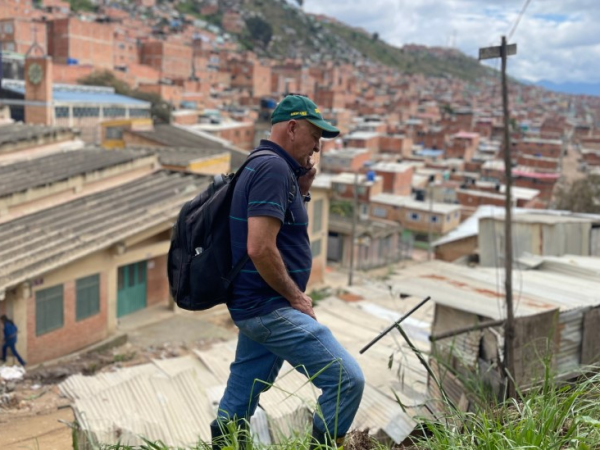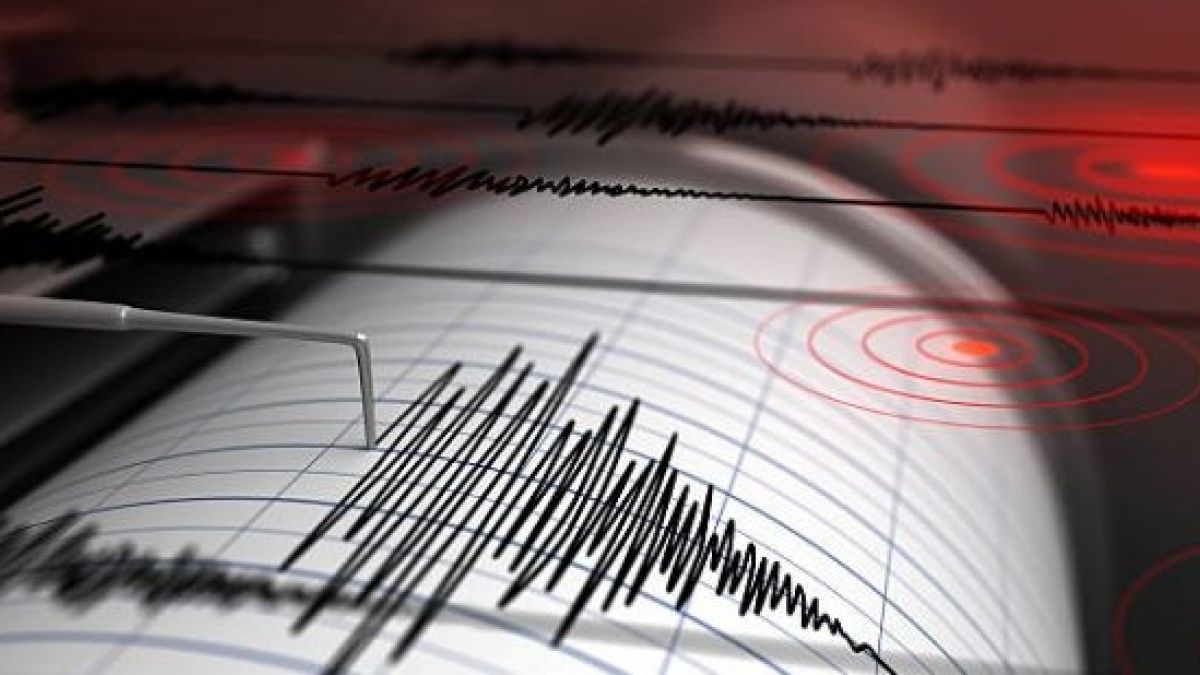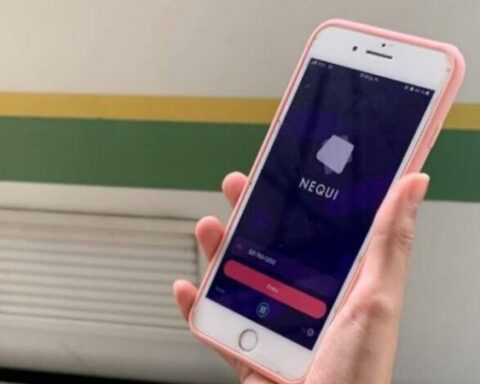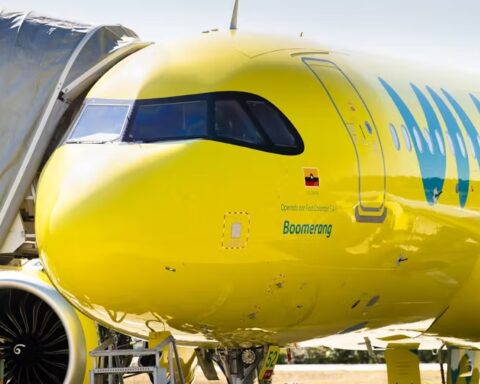Every 100 meters, at the top of the municipality of Soacha, next to Bogotá, there is a water tap on the street. Sometimes it’s in plain sight, sometimes under a rock, almost always hidden.
Every day, Javier García Villarraga must open and close these taps so that the water in the neighborhood is not scarce. The aqueduct was assembled by the community. For years they stole the water and for 15 they have received a limited ration from the Bogotá aqueduct. Garcia must dose it. They call him “the Plumber”.
With a T-shaped steel rod to hold the taps that are difficult to access, García walks around La Isla, a neighborhood in Soacha, distributing access to the service and collecting modest sums, which he writes down in a notebook, to pay for the maintenance of the system. craft.
“Rain, shine or lightening, I have to come here and open it because otherwise those people would run out of water,” he says, as he lifts a stone to open a faucet.
Thousands of people depend on it. His relationship with each one of them is cordial, formal, everyday, perhaps sometimes familiar.
Everyone who crosses his path greets him: “Don Javier”, they call him. They comment on the state of the water, they give him some fruit or candy.
“The water comes here… Not all the time and without the tank, it’s difficult, but when it comes, it comes… I’m not going to complain,” says neighbor Rosa Bravo, after negotiating the payment with Javier, who did not I had been charging him for a year.
The water arrives, yes, but intermittently. The one without a tank stays dry.
Dozens of neighborhoods in this growing municipality in the Andean antiplano need a plumber, because neither the Colombian State nor the companies linked to the water business manage to distribute it.
63 years old, García arrived in this neighborhood 32 years ago, when there were barely a few houses and thousands of people were invading it.
“Nine out of 10 people here are displaced by violence,” he estimates. “There is no region from which there are no people; the entire citizenry of this country is represented here.”
He comes from Caldas, a central-western department where, as is common there, he used to grow coffee.
“My father was the president of the town council and I was a town councilor and they (the guerrillas) simply declared us a military objective,” he recalls, when he walks, wearing rubber boots, through the swampy streets of the neighborhood, They get muddy every time it rains.
“I arrived here in this city totally ruined; physically, materially and affectively shattered.”
In Soacha, García resumed his role as social leader: he is one of the directors of the Community Board, the one that does the work of the State.
According to official figures, 6.4% of Colombians do not have access to water: for example, in La Guajira, in the north, they are even worse off than García’s neighbors. And 24% are the same: they have limited and intermittent access.
The figures for Colombia are similar to the average for Latin America, the region with the most water resources in the world (31%), but with one of the most unequal and costly distributions.
In Soacha, official data reports that 85% have access to water and 78% to sewage. These are rates similar to those of Bolivia, which has the worst coverage in the region, according to data from the Inter-American Development Bank.
“But that is underreporting,” says Heiner Gaitán, a Soachuno councilor. “Because that does not take into account the dynamics of land invasions, which continue to occur due to the mafias of the landowners, who deceive people with a promise of housing or land.”
Soacha is one of the two largest recipients of population in Colombia: in 2005, the national census reported that there were 350,000 inhabitants here; in 2018 the figure increased to 800,000; today the authorities estimate more than a million. And up.
“These neighborhoods are still subnormal neighborhoods,” says the plumber García. “They are not legalized, but we are already defined human settlements.”
Defined, but by them, who have had to manage urban development.
“The first years (30 years ago) were torture, because we had to steal the water from the pipes of the Bogota aqueduct,” he remarks.
One kilometer from the neighborhood is the border with the capital. There, for decades, the leaders of the communal council would go, break the pipes and take long hoses to their neighborhood on top of the hill.
“They were waiting for us with bullets and here we also had to go armed,” recalls García.
In 2008, the communal councils of Soacha reached an agreement with the Bogotá mayor’s office to give them free water, even if it was limited. Each of the neighborhood councils undertook to manage their artisanal aqueduct. Each one needed a plumber.
And in the La Isla sector, for eight years, he has been García, a paisa coffee grower with eloquent speech and formal dealings.
informal suburb
Soacha is in a particular condition: many consider it part of Bogotá, but it is a Cundinamarca municipality very close to the capital.
In a country where 76% of the municipalities register population decline, the pressure on places like Soacha, where the population is increasing, is notable.
The “tierreros” that Gaitán mentions are part of the cause of the population increase. They are illegal land buying and selling networks that take advantage of property loopholes. Displaced populations buy them cheap. Then they realize that they invaded a piece of land.
But in addition to this there is, according to Oscar Alfonso, an urban economist, “the centralist conception of the State that the Colombian rulers have, who have not given Soacha the metropolitan status that it already has, de facto, in its commercial and labor relations with Bogota”.
Bogotá has extraordinary water resources, but its administration does not consider Soacha as part of the city.
“The capital gives or sells the water to the municipality, instead of integrating it into its network, as it could and does happen in its socioeconomic dynamics, and that is what results not only in informalization, but also in the contamination of the resource,” Alfonso assures.
The plumber García points out that in recent years a threat has been added to the situation in the neighborhood: climate change.
Since last year, the La Niña phenomenon produced one of the worst winter seasons in the history of Colombia: 200 people died, according to official figures, as a result of landslides generated by rain.
“I had never seen such a strong winter season,” says García. “And what this brings us is an incredible hand of complications.”
Before our meeting it rained for three days in a row. The unpaved streets of Soacha had turned into mud tracks that only motorcycles and trucks can pass through.
The patio of one of the 700 houses that García is in charge of had collapsed on the roof of another.
“Fortunately we had no victims, but the aqueduct broke and we had to do a new remodeling so that the water would not be lost,” he says.
This is how Garcia’s life goes. Like that of dozens of plumbers in Soacha. Although he receives a salary for the plumbing, his bills are paid with additional plumbing jobs.
“That’s the paradox,” he says, about water scarcity while it’s pouring with rain.
“But how much would the Africans give for overwhelming waters to fall on them like the ones that have fallen these days.”
“They scare us, they embitter us, they worry us, yes, but without this water, which sometimes comes in excess, life would not be possible.”
Now you can receive notifications from BBC News World. Download the new version of our app and activate them so you don’t miss out on our best content.







